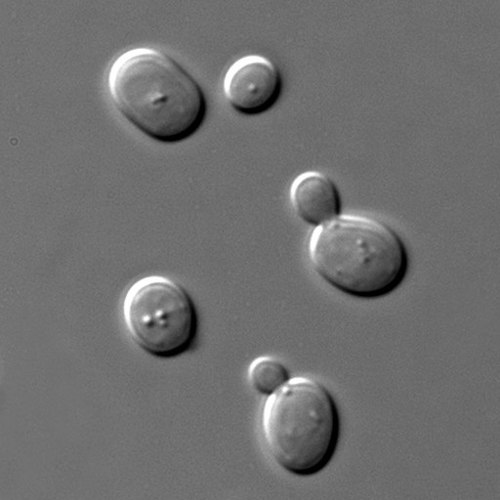2.35 复制
章节大纲
-
What you will learn
::你会学到什么-
Difference between asexual and
::性与性之间的差别 -
Major types of
::主要类型 -
What happens in sexual reproduction
::在性生殖方面发生的情况
One parent or two?
::单亲还是双亲?That is the main difference between sexual and asexual reproduction. Sexual reproduction just means combining genetic material from two parents. Asexual reproduction produces offspring genetically identical to the one parent.
::这是性生殖和性生殖的主要区别。性生殖仅仅意味着将父母双方的遗传材料结合起来。性生殖产生与父母一方在遗传上完全相同的后代。Reproduction: Asexual vs. Sexual
::生殖:性对性is how organisms grow and repair themselves. It is also how many organisms produce offspring. For many single-celled organisms, reproduction is a similar process. The parent cell simply divides to form two daughter cells that are identical to the parent. In many other organisms, two parents are involved, and the offspring are not identical to the parents. In fact, each offspring is unique. Look at the family in the Figure . The children resemble their parents, but they are not identical to them. Instead, each has a unique combination of characteristics inherited from both parents.
::生物是如何生长和自我修复的。 也是有多少生物产生后代。 对于许多单细胞生物来说, 繁殖是一个相似的过程。 父细胞只是分裂成两个与父细胞相同的女儿细胞。 在许多其他生物中, 父母有双亲, 后代与父母不同。 事实上, 每个后代都是独一无二的。 看看图中的家庭。 孩子们与父母相似, 但与父母不同。 相反, 每一个细胞都具有从父母继承的独一的特征组合。Family Portrait: Mother, Daughter, Father, and Son. Children resemble their parents, but they are never identical to them. Do you know why this is the case? Reproduction is the process by which organisms give rise to offspring. It is one of the defining characteristics of living things. There are two basic types of reproduction: asexual reproduction and sexual reproduction.
::生殖是生物产生后代的过程,是生命的决定性特征之一,生殖有两种基本类型:性生殖和性生殖。Asexual Reproduction
::性生殖Asexual reproduction involves a single parent. It results in offspring that are genetically identical to each other and to the parent. All and some eukaryotes reproduce this way. There are several different methods of asexual reproduction. They include binary fission , fragmentation , and budding .
::非性生殖涉及单亲,导致后代在遗传上与父母和父母完全相同,所有和某些eukaryotes人都以这种方式繁殖。有几种不同的性生殖方法,包括二进制裂变、分裂和萌芽。-
Binary fission
occurs when a parent cell splits into two identical daughter cells of the same size.
::二进制裂变发生时,父细胞分裂成两个相同大小的相同女儿细胞。 -
Fragmentation
occurs when a parent organism breaks into fragments, or pieces, and each fragment develops into a new organism. Starfish, like the one in the
Figure
, reproduce this way. A new starfish can develop from a single ray, or arm. Starfish, however, are also capable of sexual reproduction.
::当母体有机体破碎成碎片或碎片,而每个碎片都发展成新的有机体时,就会发生分裂。海星和图中的海星一样,以这种方式繁殖。新的海星可以从单一的射线或手臂中发育。但是,海星也可以进行性繁殖。 -
Budding
occurs when a parent cell forms a bubble-like bud. The bud stays attached to the parent cell while it grows and develops. When the bud is fully developed, it breaks away from the parent cell and forms a new organism. Budding in yeast is shown in the
Figure
.
::当母细胞形成像泡泡一样的芽时, 就会出现芽。 芽在生长和发育时会与母细胞相连。 当芽完全发育出来时, 它会脱离母细胞, 形成新的有机体。 图中显示了酵母中的芽。
Binary Fission in various single-celled organisms (left). Cell division is a relatively simple process in many single-celled organisms. Eventually the parent cell will pinch apart to form two identical daughter cells. In multiple fission (right), a multinucleated cell can divide to form more than one daughter cell. Multiple fission is more often observed among protists. Starfish reproduce by fragmentation and yeasts reproduce by budding. Both are types of asexual reproduction. Asexual reproduction can be very rapid. This is an advantage for many organisms. It allows them to crowd out other organisms that reproduce more slowly. , for example, may divide several times per hour. Under ideal conditions, 100 bacteria can divide to produce millions of bacterial in just a few hours! However, most bacteria do not live under ideal conditions. If they did, the entire surface of the planet would soon be covered with them. Instead, their reproduction is kept in check by limited resources, predators , and their own wastes. This is true of most other organisms as well.
::性生殖可以非常迅速。 这是许多生物的优势。 它允许它们排挤其他繁殖速度较慢的生物。 例如, 每小时可能分裂数倍。 在理想条件下, 100 种细菌可以在短短几个小时内分裂成数以百万计的细菌。 然而, 大多数细菌并不生活在理想条件下。 如果是这样, 整个地球表面很快就会被它们覆盖。 相反, 它们的繁殖会受到有限的资源、 捕食者 和他们自己的废物的制约。 对于大多数其它生物来说, 情况也是如此 。Sexual Reproduction
::性生殖Sexual reproduction involves two parents. As you can see from the Figure , in sexual reproduction, parents produce reproductive cells—called gametes —that unite to form an offspring. Gametes are haploid cells. This means they contain only half the number of found in other cells of the organism. Gametes are produced by a type of cell division called . The process in which two gametes unite is called . The fertilized cell that results is referred to as a zygote . A zygote is diploid cell, which means that it has twice the number of chromosomes as a gamete.
::从图中可以看出,在性生殖方面,父母生产生殖细胞,即所谓的调子细胞,以形成后代。调子细胞是杂交细胞,仅包含在生物体其他细胞中发现的数量的一半。调子是由一种叫作“两个调子组合”的细胞分裂产生的。结果被称为“zygote”的受精细胞被称作“zygote”。 zygote是diploid细胞,这意味着其染色体数是作为调子的两倍。DID YOU KNOW? Asexual reproduction in vertebrates occurs rarely. Some vertebrates like Komodo dragons reproduce asexually by parthenogenesis . In this process, females produce eggs that develop into offspring without being fertilized by . Check your understanding!
::检查你的理解!
Summary
::摘要-
Asexual reproduction involves one parent and produces offspring that are genetically identical to each other and to the parent.
::性生殖涉及父母一方,产生在遗传上与父母和父母完全相同的后代。 -
Sexual reproduction involves two parents and produces offspring that are genetically unique.
::性生殖涉及双亲,产生遗传上独特的后代。 -
During sexual reproduction, two haploid gametes join in the process of fertilization to produce a diploid zygote.
::在性生殖期间,两个杂乱无章的恋童癖者加入施肥过程,以产生一种低脂的zygote。 -
Meiosis is the type of cell division that produces gametes.
::Meisisis 是产生数子的细胞分裂类型。
Review
::回顾-
What are three types of asexual reproduction?
::什么是三种性生殖? -
Define gamete and zygote. What number of chromosomes does each have (in humans)?
::定义 gamete 和 zygote 。 每种染色体( 人类) 有多少 ? -
What happens during fertilization?
::施肥期间会发生什么? -
Compare and contrast asexual and sexual reproduction.
::比较和对比非性生殖和性生殖。
-
Difference between asexual and




